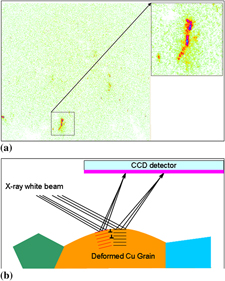Published online by Cambridge University Press: 11 February 2011

Strain evolution in 0.45-μm-thick, 2-μm-wide, and 100-μm-long Cu conductor lines with a passivation layer has been investigated using synchrotron x-ray microdiffraction. A moderate electromigration-current density of 2.2 × 105 A/cm2 was used to minimize Joule heating in the Cu conductor lines. After 120 h of current flowing in the Cu lines at 270 °C, measurements show strain relaxation and homogenization occurring in the Cu lines with current flowing, but not in Cu conductor lines without current. Stronger interaction between electrons with Cu atoms in areas with higher strains was proposed to explain the observation.
The purpose of this Materials Communications section is to provide accelerated publication of important new results in the fields regularly covered by Journal of Materials Research, Materials Communications cannot exceed four printed pages in length, including space allowed for title, figures, tables, references, and an abstract limited to about 100 words